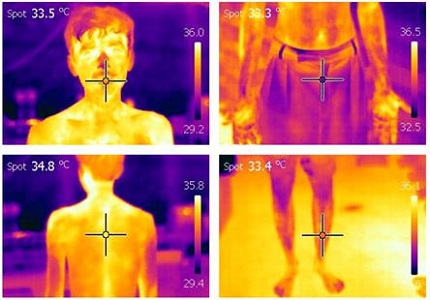Thermophysiological vulnerability to Heat stress among Indoor workers
Abstract
Introduction: The present study provides a practical importance to assess the magnitude of thermal stress of workers in indoor environment taking into account the workers physiological responses.
Method: The study covered indoor workers iron (N=587years) and ceramics (N=426) in three seasons. Thermal measurements were recorded by Wet Bulb Globe Temperature (WBGT) Monitor. The physiological responses include skin temperature, heart rate and blood pressure.
Results: The WBGT index in summer month of ceramic (34.9±2.7°C) was higher than iron foundry works (32±1.7°C). The systolic blood pressures in winter month were higher, as compared to summer months (2mm Hg in iron and 11mm Hg in ceramic). About 32% of iron and ceramic workers had working heart rate greater than 100 beats/min and 3% beyond 130 beats/min during the working day. The skin temperature (Tsk) profile and weighted skin temperature (Tsk) were significantly higher in summer, followed by post-monsoon and winter months.
Discussion: The study assesses the physiological and thermoregulatory responses of workers to heat stress and strain for their exposure to extreme hot environment. The limit of peripheral thermoregulatory adjustability may be considered beneficial and can be taken away from the fury of high heat.
Downloads
References
2. Bates GP, Miller VS. Sweat rate and sodium loss during work in the heat. J Occup Med Toxicol. 2008;3(4).
3. Dash S, Kjellstrom T. Workplace heat stress in the context of rising temperature in India. Current Science. 2011;101(4):496.
4. Davies C. Thermal limits to severe prolonged exercise in man. Journal of Thermal Biology. 1993;18(5):605-607. [PubMed]
5. Ignjatović A, Hofmann P, Radovanović D. Non-invasive determination of the anaerobic threshold based on the heart rate deflection point. Facta universitatis-series: Physical Education and Sport. 2008;6(1):1-10.
6. Parsons K. Maintaining health, comfort and productivity in heat waves. Global Health Action. 2009;2.
7. Cheuvront SN, Carter R, Sawka MN. Fluid balance and endurance exercise performance. Curr Sports Med Rep. 2003;2(4):202-208. [PubMed]
8. Nag P, Dutta P, Nag A. Critical body temperature profile as indicator of heat stress vulnerability. Industrial health. 2012;51(1):113-122.
9. Miller VS, Bates GP. Hydration, hydration, hydration. Annals of occupational hygiene. 2010;54(2):134-136.
10. ICMR. Ethical guidelines for biomedical research on human subject. Indian Council of Medical Research;2000.
11. Liljegren JC, Carhart RA, Lawday P, Tschopp S, Sharp R. Modeling the wet bulb globe temperature using standard meteorological measurements. Journal of Occupational and Environmental Hygiene. 2008;5(10):645-655. [PubMed]
12. ACGIH. TLVs and BEIs—Threshold limit values for chemical substances and physical agents biological exposure indices. ACGIH Worldwide ISBN. 2002:1-882417.
13. Nag PK, Nag A, Ashtekar SP. Thermal limits of men in moderate to heavy work in tropical farming. Industrial health. 2007;45(1):107-117.
14. O'Grady NP, Barie PS, Bartlett JG, et al. Practice guidelines for evaluating new fever in critically ill adult patients. Clinical infectious diseases. 1998;26(5):1042-1059.
15. Motamedzade M, Azari MR. Heat stress evaluation using environmental and biological monitoring. Pakistan Journal of Biological Sciences. 2006;9(3):457-459.
16. Brugniaux JV, Niva A, Pulkkinen I, Laukkanen RM, Richalet J-P, Pichon AP. Polar Activity Watch 200: a new device to accurately assess energy expenditure. British journal of sports medicine. 2010;44(4):245-249.
17. Nag P, Sebastian N, Malvankar M. Effective heat load on agricultural workers during summer season. 1980.
18. Alpérovitch A, Lacombe J-M, Hanon O, et al. Relationship between blood pressure and outdoor temperature in a large sample of elderly individuals: the Three-City study. Archives of internal medicine. 2009;169(1):75. [PubMed]
19. Epstein Y, Moran DS. Thermal comfort and the heat stress indices. Industrial Health. 2006;44(3):388-398.
20. Kristal-Boneh E, Harari G, Green MS, Ribak J. Seasonal changes in ambulatory blood pressure in employees under different indoor temperatures. Occupational and environmental Medicine. 1995;52(11):715-721.
21. Hata T, Ogihara T, Maruyama A, et al. The seasonal variation of blood pressure in patients with essential hypertension. Clinical and Experimental Hypertension. 1982;4(3):341-354.
22. Kim Y-M, Kim S, Cheong H-K, Ahn B, Choi K. Effects of Heat Wave on Body Temperature and Blood Pressure in the Poor and Elderly. Environmental health and toxicology. 2012;27.
23. Galloway SD, Maughan RJ. The effects of substrate and fluid provision on thermoregulatory and metabolic responses to prolonged exercise in a hot environment. Journal of Sports Sciences. 2000;18(5):339-351. [PubMed]
24. Inbar O, Morris N, Epstein Y, Gass G. Comparison of thermoregulatory responses to exercise in dry heat among prepubertal boys, young adults and older males. Experimental physiology. 2004;89(6):691-700.

Copyright (c) 2014 Author (s). Published by Siddharth Health Research and Social Welfare Society

This work is licensed under a Creative Commons Attribution 4.0 International License.


 OAI - Open Archives Initiative
OAI - Open Archives Initiative


